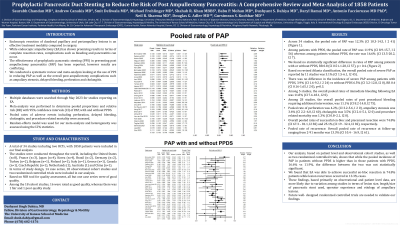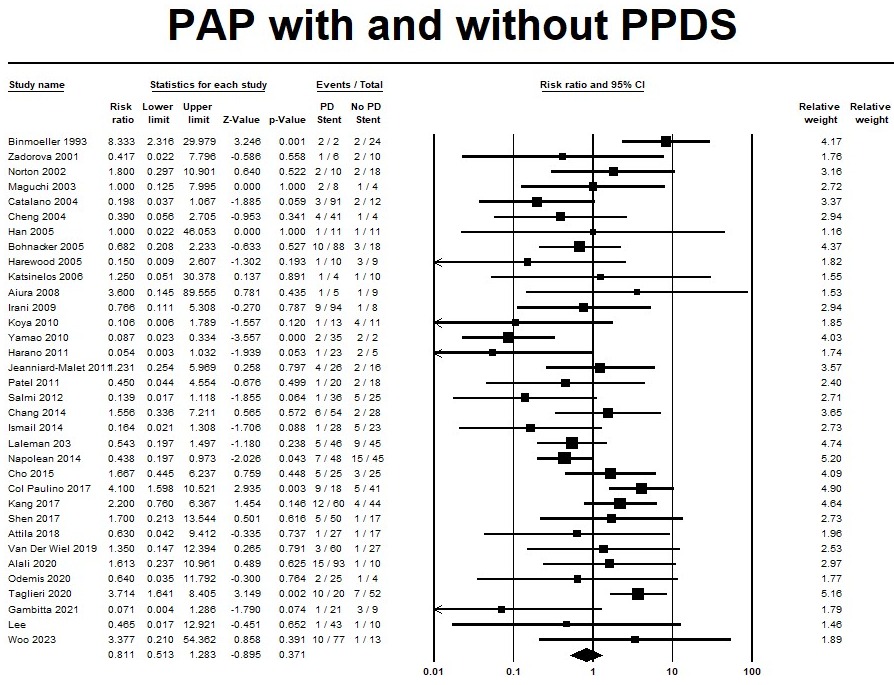Sunday Poster Session
Category: Biliary/Pancreas
P0026 - Prophylactic Pancreatic Duct Stenting to Reduce the Risk of Post Ampullectomy Pancreatitis: A Comprehensive Review and Meta-Analysis of 1858 Patients
Sunday, October 22, 2023
3:30 PM - 7:00 PM PT
Location: Exhibit Hall

Has Audio

Dushyant Singh Dahiya, MD
University of Kansas School of Medicine
Kansas City, KS
Presenting Author(s)
Saurabh Chandan, MD1, Andrew Canakis, DO2, Smit Deliwala, MD3, Michael Frohlinger, MD2, Dushyant Singh. Dahiya, MD4, Shahab R. Khan, MBBS5, Babu Mohan, MD, MS6, Daryl Ramai, MD7, Antonio Facciorusso, MD8, Neil R.. Sharma, MD9, Douglas G. Adler, MD10, Gursimran S. Kochhar, MD11
1Creighton University School of Medicine, Omaha, NE; 2University of Maryland School of Medicine, Baltimore, MD; 3Emory University School of Medicine, Atlanta, GA; 4University of Kansas School of Medicine, Kansas City, KS; 5Brigham and Women's Hospital, Harvard Medical School, Boston, MA; 6University of Utah Health School of Medicine, Salt Lake City, UT; 7University of Utah School of Medicine, Salt Lake City, UT; 8University of Foggia, Foggia, Italy, Neptune, NJ; 9Parkview Cancer Institue, Fort Wayne, IN; 10Center for Advanced Therapeutic (CATE), Centura Health, Porter Adventist Hospital, Peak Gastroenterology, Denver, CO; 11Allegheny Health Network, Pittsburgh, PA
Introduction: Endoscopic ampullectomy (EA) for ampullary lesions is an effective treatment modality compared to surgery. However, complications such as bleeding, papillary stenosis and pancreatitis can occur. The effectiveness of prophylactic pancreatic duct stenting (PPDS) in preventing post ampullectomy pancreatitis (PAP) has been reported, however results are conflicting. We conducted a systematic review and meta-analysis looking at the use of PPDS in reducing PAP as well as overall post ampullectomy complications.
Methods: Multiple databases were searched through May 2023. Meta-analysis was performed to determine pooled proportions and relative risk (RR) with 95% confidence intervals (CI) of PAP, with and without PPDS. Pooled rates of adverse events including perforation, delayed bleeding, cholangitis, and procedure related mortality were assessed. Random-effects model was used for our meta-analysis.
Results: Thirty-four studies with 1858 patients (1217 with PPDs, 623 without PPDs) were included in our final analysis. The overall pooled rate of PAP was 12.3% (CI 10.3-14.5, I2 41). We found no statistically significant difference in rates of PAP among patients with PPDS, 11.9% (CI 8.9-15.7, I2 56) and without PPDS, 16.6% (CI 13.5-20.2, I2 7), RR 0.8 (CI 0.51-1.28, I2 57), p=0.4 [Figure 1]. In terms of severe PAP, we found no difference between the two groups, RR 0.5 (CI 0.16-1.65, I2 0), p=0.3. Among all studies conducted in USA, Europe, those with >50 patients and published as full-length manuscripts, we found that while pooled rate of PAP was numerically in higher in patients without PPDS compared to those with PPDS, the difference between the two did not reach statistical significance, RR 0.5 (CI 0.24-1.07, I2 0), p=0.07; RR 0.7 (CI 0.31-1.4, I2 58), p=0.3, RR 0.95 (CI 0.56-1.62, I2 57), p=0.9 and RR 0.73 (CI 0.45-1.19, I2 54), p=0.2, respectively. Overall pooled rates of successful en-bloc, piecemeal resection, ampullary stenosis, post procedural bleeding, perforation, cholangitis and procedure related mortality were 74.8%, 25.1%, 3.6%, 11.1%, 4.2%, 3.5%, and 1.3%, respectively.
Discussion: Our analysis shows that PPDS at the time of EA offers a protective effect against PAP. While we were unable to find a statistically significant difference among the PPDS vs no PPDS group, this is likely due to variation among studies in terms of lesion size, length/size of pancreatic stent used and etiology of ampullary lesions. Future well-designed trials are needed to validate our findings.

Disclosures:
Saurabh Chandan, MD1, Andrew Canakis, DO2, Smit Deliwala, MD3, Michael Frohlinger, MD2, Dushyant Singh. Dahiya, MD4, Shahab R. Khan, MBBS5, Babu Mohan, MD, MS6, Daryl Ramai, MD7, Antonio Facciorusso, MD8, Neil R.. Sharma, MD9, Douglas G. Adler, MD10, Gursimran S. Kochhar, MD11. P0026 - Prophylactic Pancreatic Duct Stenting to Reduce the Risk of Post Ampullectomy Pancreatitis: A Comprehensive Review and Meta-Analysis of 1858 Patients, ACG 2023 Annual Scientific Meeting Abstracts. Vancouver, BC, Canada: American College of Gastroenterology.
1Creighton University School of Medicine, Omaha, NE; 2University of Maryland School of Medicine, Baltimore, MD; 3Emory University School of Medicine, Atlanta, GA; 4University of Kansas School of Medicine, Kansas City, KS; 5Brigham and Women's Hospital, Harvard Medical School, Boston, MA; 6University of Utah Health School of Medicine, Salt Lake City, UT; 7University of Utah School of Medicine, Salt Lake City, UT; 8University of Foggia, Foggia, Italy, Neptune, NJ; 9Parkview Cancer Institue, Fort Wayne, IN; 10Center for Advanced Therapeutic (CATE), Centura Health, Porter Adventist Hospital, Peak Gastroenterology, Denver, CO; 11Allegheny Health Network, Pittsburgh, PA
Introduction: Endoscopic ampullectomy (EA) for ampullary lesions is an effective treatment modality compared to surgery. However, complications such as bleeding, papillary stenosis and pancreatitis can occur. The effectiveness of prophylactic pancreatic duct stenting (PPDS) in preventing post ampullectomy pancreatitis (PAP) has been reported, however results are conflicting. We conducted a systematic review and meta-analysis looking at the use of PPDS in reducing PAP as well as overall post ampullectomy complications.
Methods: Multiple databases were searched through May 2023. Meta-analysis was performed to determine pooled proportions and relative risk (RR) with 95% confidence intervals (CI) of PAP, with and without PPDS. Pooled rates of adverse events including perforation, delayed bleeding, cholangitis, and procedure related mortality were assessed. Random-effects model was used for our meta-analysis.
Results: Thirty-four studies with 1858 patients (1217 with PPDs, 623 without PPDs) were included in our final analysis. The overall pooled rate of PAP was 12.3% (CI 10.3-14.5, I2 41). We found no statistically significant difference in rates of PAP among patients with PPDS, 11.9% (CI 8.9-15.7, I2 56) and without PPDS, 16.6% (CI 13.5-20.2, I2 7), RR 0.8 (CI 0.51-1.28, I2 57), p=0.4 [Figure 1]. In terms of severe PAP, we found no difference between the two groups, RR 0.5 (CI 0.16-1.65, I2 0), p=0.3. Among all studies conducted in USA, Europe, those with >50 patients and published as full-length manuscripts, we found that while pooled rate of PAP was numerically in higher in patients without PPDS compared to those with PPDS, the difference between the two did not reach statistical significance, RR 0.5 (CI 0.24-1.07, I2 0), p=0.07; RR 0.7 (CI 0.31-1.4, I2 58), p=0.3, RR 0.95 (CI 0.56-1.62, I2 57), p=0.9 and RR 0.73 (CI 0.45-1.19, I2 54), p=0.2, respectively. Overall pooled rates of successful en-bloc, piecemeal resection, ampullary stenosis, post procedural bleeding, perforation, cholangitis and procedure related mortality were 74.8%, 25.1%, 3.6%, 11.1%, 4.2%, 3.5%, and 1.3%, respectively.
Discussion: Our analysis shows that PPDS at the time of EA offers a protective effect against PAP. While we were unable to find a statistically significant difference among the PPDS vs no PPDS group, this is likely due to variation among studies in terms of lesion size, length/size of pancreatic stent used and etiology of ampullary lesions. Future well-designed trials are needed to validate our findings.

Figure: Figure 1 - Forest Plot, RR, PAP with and without PPDS
Disclosures:
Saurabh Chandan indicated no relevant financial relationships.
Andrew Canakis indicated no relevant financial relationships.
Smit Deliwala indicated no relevant financial relationships.
Michael Frohlinger indicated no relevant financial relationships.
Dushyant Dahiya indicated no relevant financial relationships.
Shahab Khan indicated no relevant financial relationships.
Babu Mohan indicated no relevant financial relationships.
Daryl Ramai indicated no relevant financial relationships.
Antonio Facciorusso indicated no relevant financial relationships.
Neil Sharma indicated no relevant financial relationships.
Douglas Adler indicated no relevant financial relationships.
Gursimran Kochhar: CorEvitas Research Foundation – Advisory Committee/Board Member. Digbi Health – Stock Options. GIE Medical – Advisory Committee/Board Member. Lilly Pharma – Advisory Committee/Board Member. Lilly Pharma – Speaker for Lilly Pharma. Pentax Endoscopy – Consultant.
Saurabh Chandan, MD1, Andrew Canakis, DO2, Smit Deliwala, MD3, Michael Frohlinger, MD2, Dushyant Singh. Dahiya, MD4, Shahab R. Khan, MBBS5, Babu Mohan, MD, MS6, Daryl Ramai, MD7, Antonio Facciorusso, MD8, Neil R.. Sharma, MD9, Douglas G. Adler, MD10, Gursimran S. Kochhar, MD11. P0026 - Prophylactic Pancreatic Duct Stenting to Reduce the Risk of Post Ampullectomy Pancreatitis: A Comprehensive Review and Meta-Analysis of 1858 Patients, ACG 2023 Annual Scientific Meeting Abstracts. Vancouver, BC, Canada: American College of Gastroenterology.
